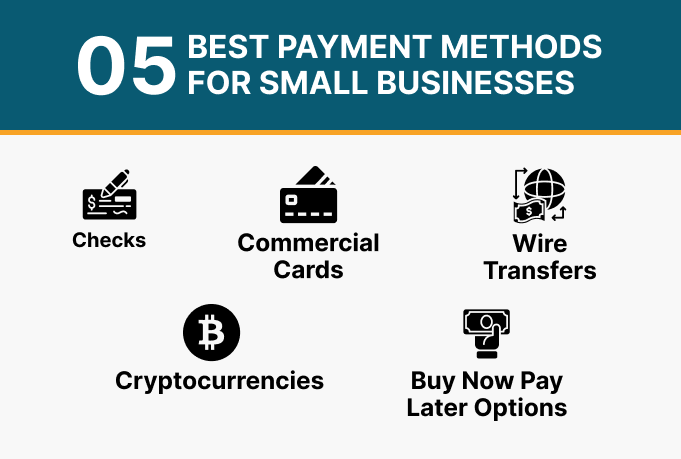
Digitalization has made payment methods an essential part of business operations, especially for small businesses. They now rely on systems that are easy to use, reliable, and fast.
Having more than one business payment method is largely helpful for small businesses. Because it gives flexibility and makes it easier to serve a wider range of customers. To understand its importance, let’s look at some numbers. In 2022, businesses in the U.S. spent about $160.7 billion in processing fees to accept over $10 trillion in payments made through credit, debit, and prepaid cards. This shows how important payment systems are to the economy. At the same time, these high fees have encouraged many businesses to look for alternative payment processing solutions that can help reduce costs and improve efficiency.
However, there are so many payment systems for small businesses available today. So, choosing the right one can feel complicated. That’s why, in this blog, we’ll walk through the different payment methods for small businesses and explain how to decide which option might be the best fit for your business model.
Before that, let’s understand…
Why Business Payment Methods are Essential?
In today’s competitive marketplace, payments go beyond just transactions. It is more about experience now. Moreover, the method you choose to accept payments directly impacts your sales, cash flow, customer relationships, and long-term success.
Here are a few key points to understand why the payment system for small businesses holds so much importance:
1. Cash Flow Is the Lifeblood of Your Business
A business might be able to run without profits for some time, but it cannot survive without cash flow. That’s why choosing payment methods that allow faster settlements and fewer delays is so important.
2. Customers Expect Convenience
Modern customers want flexibility. Some prefer paying with cards, while others use BNPL plans, digital wallets, or bank transfers. If a business limits options, it risks losing sales. On the other hand, offering multiple methods increases conversions and makes the buying process frictionless.
3. Cost and Fees Add Up
Transaction fees, gateway charges, and hidden costs can eat into your margins. By carefully analyzing the cost structure of each small business payment option, businesses can choose a mix that maximizes efficiency while minimizing expenses.
4. Trust and Security Are Non-Negotiable
If customers don’t feel safe entering their details, they abandon the purchase. For this reason, you must choose business payment methods that are PCI-compliant, fraud-protected, and widely trusted is critical for both reputation and revenue.
5. Expanding Market Reach
The right business payment method allows you to serve more customers. For instance, offering installment plans can make your product or service accessible to customers who can't afford a large upfront payment. Furthermore, if you use modern payment methods, they generally offer faster, more efficient transaction processing as compared to traditional methods.
Worldwide Accepted Business Payment Methods

1. Checks
Despite the shift toward digital payments, checks continue to play a significant role in business transactions. Around 40% of B2B payments in the U.S. are still made with paper checks. Many companies keep using them because they seem simple, fit easily into established processes, and feel familiar.
At the same time, the demand for faster, more convenient payments and the automation of accounting tasks is rising. It makes paper checks less practical than before.
Pros:
- They are easy to track, since each payment leaves a clear trail.
- Their slower processing can give buyers more time to manage their cash.
Cons:
- Manual handling increases the risk of delays, mistakes, and added costs.
- This business payment method cycle can stretch up to 14 days. It slows down collections and puts pressure on cash flow.
2. Commercial Cards
On average, commercial card payments account for half of small business sales. These cards work like regular credit cards but are tailored for business needs such as paying suppliers, handling travel costs, or covering daily expenses. When businesses use a commercial card, networks like Visa or MasterCard process the payment. The card issuer is often a financial institution. But in some cases, American Express or Discover decides whether to approve or deny the transaction.
Pros:
- Easy to track and manage expenses with detailed reports.
- A quick and convenient way to pay suppliers.
Cons:
- Processing fees can be higher compared to other methods.
- Not all vendors are willing to accept card payments, especially for large transactions.
3. Wire Transfers
Wire transfers allow businesses and individuals to send money quickly and safely, whether across town or across the globe. Instead of physical cash, the transfer happens electronically between banks. The sender usually provides details like the recipient’s name and account number to complete the transaction. These business payment methods are handled through systems such as Fedwire in the U.S. or SWIFT internationally. In addition, non-bank providers like Western Union also offer wire transfer services, making the method widely accessible.
Pros:
- This business payment method sends money fast, often on the same day.
- Transfers are generally secure and reliable.
Cons:
- Fees can be high, especially for cross-border transfers.
- Mistakes are hard to fix since transfers are difficult to reverse.
4. Cryptocurrencies
Over 85% of U.S. merchants consider accepting cryptocurrency payments. By eliminating the need for intermediaries, they rely on digital coins like Bitcoin or Ethereum. They can be exchanged directly between parties through blockchain networks. This makes payments fast and secure without relying on traditional financial systems.
While still not as common as above mentioned business payment methods, cryptocurrency is slowly becoming more popular as businesses are expanding globally.
Pros:
- Usually, lower fees than credit cards or bank transfers.
- Works worldwide, without worrying about currency conversions.
Cons:
- Price changes can cause businesses to lose value if coins drop suddenly.
- Requires technical knowledge and tools like wallets or payment processors.
Crypto adoption is rising in cross-border B2B trade, and forecasts suggest blockchain transactions could reach 745 million by late 2025.
5. Buy Now, Pay Later Options
BNPL is proving its value: 45.2% of retailers that provide this payment option have experienced higher turnover in the last year. Meanwhile, 52.6% of retailers are either already using BNPL or preparing to introduce it.
Source: Forbes
Buy Now, Pay Later (BNPL) is becoming one of the most talked-about business payment methods in today’s market. Beyond the obvious benefit of attracting customers with flexible payment options, BNPL is a powerful tool for business growth. Modern BNPL solutions are often embedded directly into your system, simplifying the payment process and allowing you to easily track receivables. This efficiency means less manual effort for your staff. While providers typically charge a fee of 4-6% per transaction, many businesses find that this cost is easily offset by the significant increase in sales and customer conversion.
Pros:
- Customers are more likely to complete purchases when payment is spread out.
- Transactions are usually processed quickly with minimal requirements in this business payment method.
Cons:
- Merchants often pay higher fees to BNPL providers compared to traditional payments.
- Businesses may not receive the full payment upfront, depending on the provider.
Why Business Payment Methods Like Credee Matter?
If you’re searching for interest-free business payments or no-credit-check business financing, Credee has to be your one-stop solution. It is one such BNPL option that does not conduct a credit check.
Key features of Credee as a flexible payment solution for businesses:
Consistent and Predictable Income
You get paid on a set schedule, even if a customer is late with a payment. This helps you manage your money better and lowers your financial risk.
Easy to Manage
Credee, as a business payment method, automates everything from setting up payment plans to sending reminders and collecting late payments. This means your staff can spend less time on paperwork and more time on other important tasks.
Simple to Set Up
Credee easily connects with your existing business tools and website, so you can offer it to customers without any hassle.
Wider Reach
With support for many different currencies and languages, Credee makes it easy to serve customers from all over the world.
All-in-all, Credee acts as a Buy Now, Pay Later (BNPL) solution that gives customers the flexible payments they want while giving your business the reliable income and strong customer relationships you need.
Key Factors To Consider When Choosing a Business Payment Method
It’s true that small businesses can choose from many different business payment options. But the truth is, not every option will work perfectly for your needs. That’s why you need to think carefully before deciding on one. With the right approach, you can select the best payment method for your small business.
Here are a few things to think about before deciding:
Fees and Costs – Some payment methods, like credit cards, have higher fees, while others, like bank transfers, can be cheaper.
How Fast You Get Paid – Getting money quickly keeps your cash flow healthy. Card payments and wires are faster than checks.
What Your Customers Want – If customers prefer using digital wallets or cards, offering those options can make them more likely to buy from you.
Security – Safe and reliable payment methods protect your business and give customers peace of mind.
Room to Grow – Pick a method that can keep up as your business expands, whether that means more transactions or international sales.
Choosing a Convenient Payment Method Is the Key
Today, small businesses have a vast number of payment options, including cards, bank transfers, digital wallets, and installment plans. However, not every business payment method is the right fit. Choosing the wrong one can lead to high costs, slower transactions, and a poor customer experience. A well-chosen payment method does more than just simplify transactions. It can also improve your cash flow, reduce fees, and build stronger relationships with your customers. In summary, the right payment system for a small business benefits both you and the people you serve.
FAQs
1. Are There Any Affordable Payment Methods for Businesses?
Options like ACH transfers, digital wallets, and BNPL solutions (like Credee) help reduce processing fees while ensuring faster cash flow.
2. How Do Online Payment Methods Work for Small Businesses?
Online payment methods let small businesses accept money from customers through secure digital platforms. Customers pay using cards, bank transfers, or wallets, and the funds are processed through a payment gateway.
3. What Is the Best Way To Accept Payments for a Small Business?
The best way to accept payments for a small business is to offer flexible options—like cards, bank transfers, digital wallets, and BNPL plans.
4. What Are Business Financing Options Without Credit Checks?
Business financing options without credit checks give small businesses access to funds without relying on traditional credit scores. Solutions like revenue-based financing, or no-credit-check BNPL options such as Credee can help.
5. What Is the Best Payment Method for a Small Business in Jacksonville, FL?
The best payment method for a small business in Jacksonville, FL, depends on your needs. Local providers like EMS and First City Payments offer tailored POS services, while national options like Square and PayPal provide flexibility. For businesses wanting to offer Buy Now, Pay Later plans, Credee is a great choice to boost sales and customer affordability.





